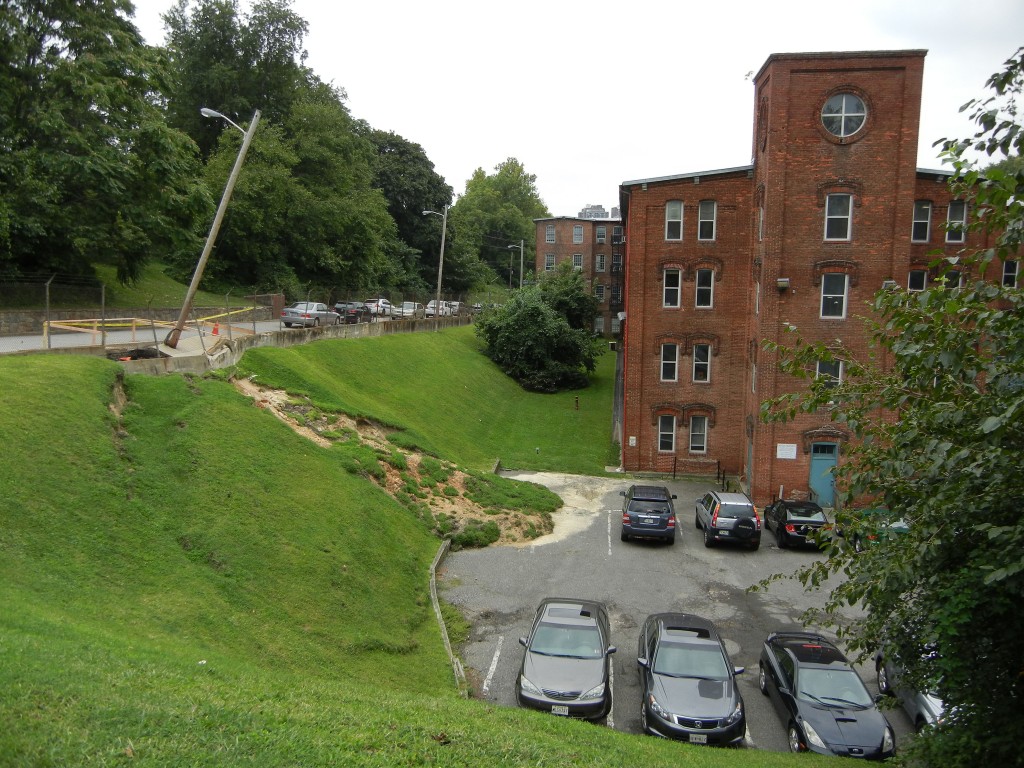 4/20: I write an email to a scientist. I explain that I work in an old building that sits in a sort of pit, partly surrounded by a hill. Midway along the hill is a little terrace on which is a street, and along the street, a sidewalk and a wire fence; and they’re all held in place by a retaining wall. The scientist is a hillslope geomorphologist. He knows about how water moves underground; how it percolates through soil of varied porosities and permeabilities; and how, pulled by gravity, it imperceptibly carries soil from one place to another. I suspect doom is unfolding. “I have an odd question for you,” I write.
4/20: I write an email to a scientist. I explain that I work in an old building that sits in a sort of pit, partly surrounded by a hill. Midway along the hill is a little terrace on which is a street, and along the street, a sidewalk and a wire fence; and they’re all held in place by a retaining wall. The scientist is a hillslope geomorphologist. He knows about how water moves underground; how it percolates through soil of varied porosities and permeabilities; and how, pulled by gravity, it imperceptibly carries soil from one place to another. I suspect doom is unfolding. “I have an odd question for you,” I write.
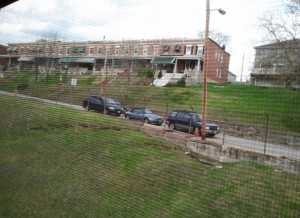 I begin by attaching to the email a picture taken from my window. “This spring the sidewalk began slipping noticeably down the hill,” I write, “The hill itself looks like it’s tearing. And you can’t see in the picture how much that electric light pole is leaning. I diagnose a groundwater problem – it looks like water is creeping underground from the top of the hill, under the street and the sidewalk and is undermining both of them plus the hill on the down-side. Do you think I’m right?” I think he’ll be interested. Apparently not; he never answers. I carry on with the normal Baltimore summer.
I begin by attaching to the email a picture taken from my window. “This spring the sidewalk began slipping noticeably down the hill,” I write, “The hill itself looks like it’s tearing. And you can’t see in the picture how much that electric light pole is leaning. I diagnose a groundwater problem – it looks like water is creeping underground from the top of the hill, under the street and the sidewalk and is undermining both of them plus the hill on the down-side. Do you think I’m right?” I think he’ll be interested. Apparently not; he never answers. I carry on with the normal Baltimore summer.
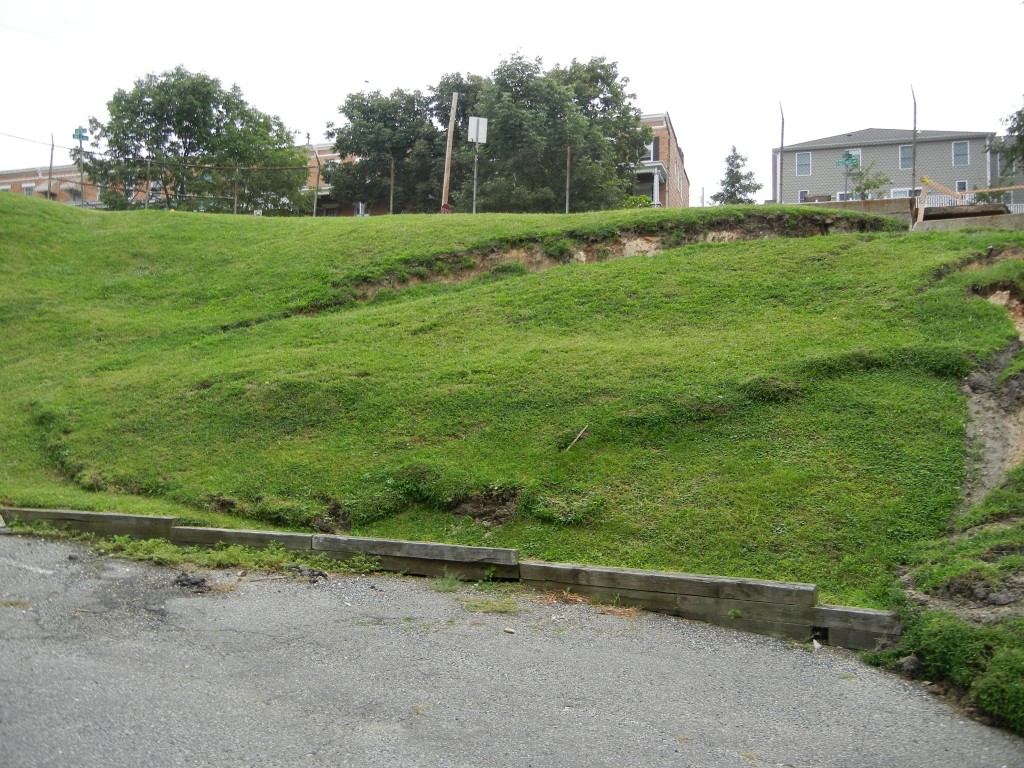 8/3 to 8/22: Baltimore gets 5.3 inches of rain; the average is 2.5 inches. The hill slides a little and pulls away long the tear lines, like it’s ripping. I remember from a night school geology class that the angle of repose — the angle at which a pile of soil, sand, sugar, salt stops slipping and comes to rest — depends on the material that’s reposing. And I find on Wikipedia that the angle of repose of dry clay is fairly steep, up to 40 degrees, but the angle of repose for wet clay is much shallower, 15 degrees. That hill is clay, wet, and at about 35 degrees.
8/3 to 8/22: Baltimore gets 5.3 inches of rain; the average is 2.5 inches. The hill slides a little and pulls away long the tear lines, like it’s ripping. I remember from a night school geology class that the angle of repose — the angle at which a pile of soil, sand, sugar, salt stops slipping and comes to rest — depends on the material that’s reposing. And I find on Wikipedia that the angle of repose of dry clay is fairly steep, up to 40 degrees, but the angle of repose for wet clay is much shallower, 15 degrees. That hill is clay, wet, and at about 35 degrees.
8/23: Baltimore has an earthquake, magnitude 5.8. My office building rumbles and then I swear, it moves. It does a little hula dance. I worry about 19th century masonry pancaking, which it doesn’t, and I’m too rattled to look at the hill. Later I wonder if the soil got somehow fluffed up.
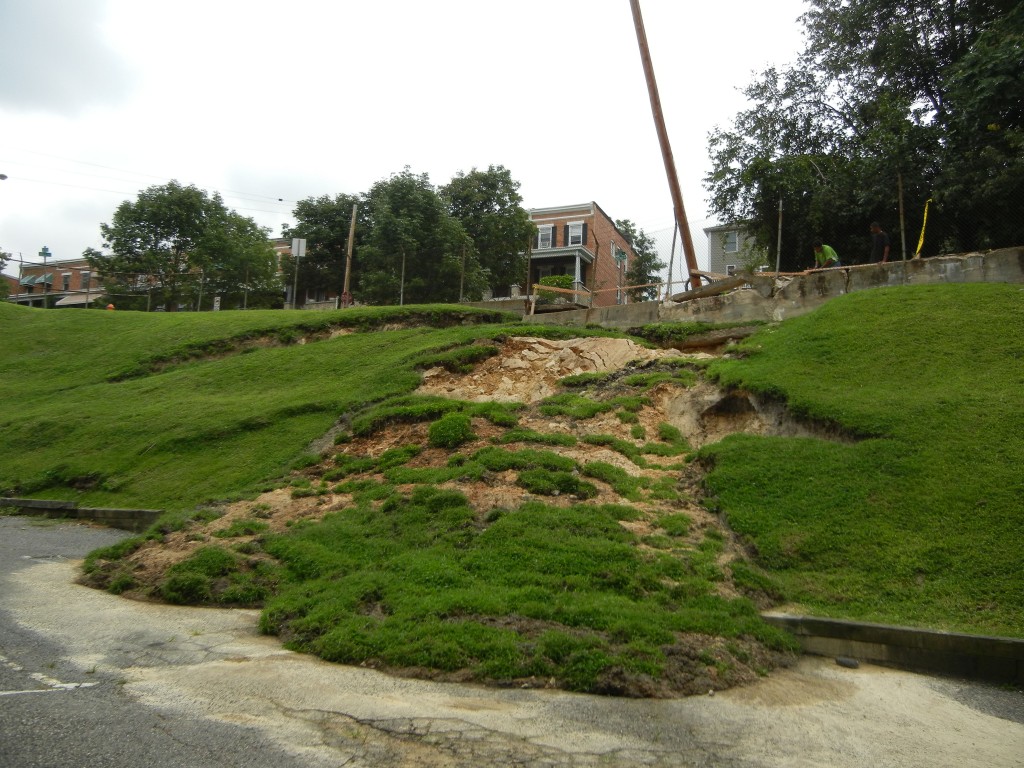 8/27: Hurricane Irene hits Baltimore as a tropical storm, 3.6 inches of rain. Inside the hill, water fills up the tiny spaces between the particles of soil, loosening their connections with each other. The particles move freely and easily. On the soil particles and the water alike, gravity pulls in just the one direction: down.
8/27: Hurricane Irene hits Baltimore as a tropical storm, 3.6 inches of rain. Inside the hill, water fills up the tiny spaces between the particles of soil, loosening their connections with each other. The particles move freely and easily. On the soil particles and the water alike, gravity pulls in just the one direction: down.
The hill pulls apart along the tear lines and the slide turns into a slump. Above the slump are new tear lines. Part of the hill detaches and heads for lower ground. The sidewalk drops a foot or so. The electric light pole looks tired. I need my friend Julia to take pictures.
9/5: Tropical Storm Lee moves in and stays. The sidewalk drops another foot, slides into the retaining wall, and cracks it. The electric light pole rests gently on the wire fence. The new tear lines above the slump deepen into a rift, then a secondary slump. The primary slump crawls over the parking lot. The soil in the slump is loose and liquid; you can scoop it with your hands like beach sand. It must be at least half water. Its angle of repose must be 3 degrees, I mean, like practically water’s angle of repose.
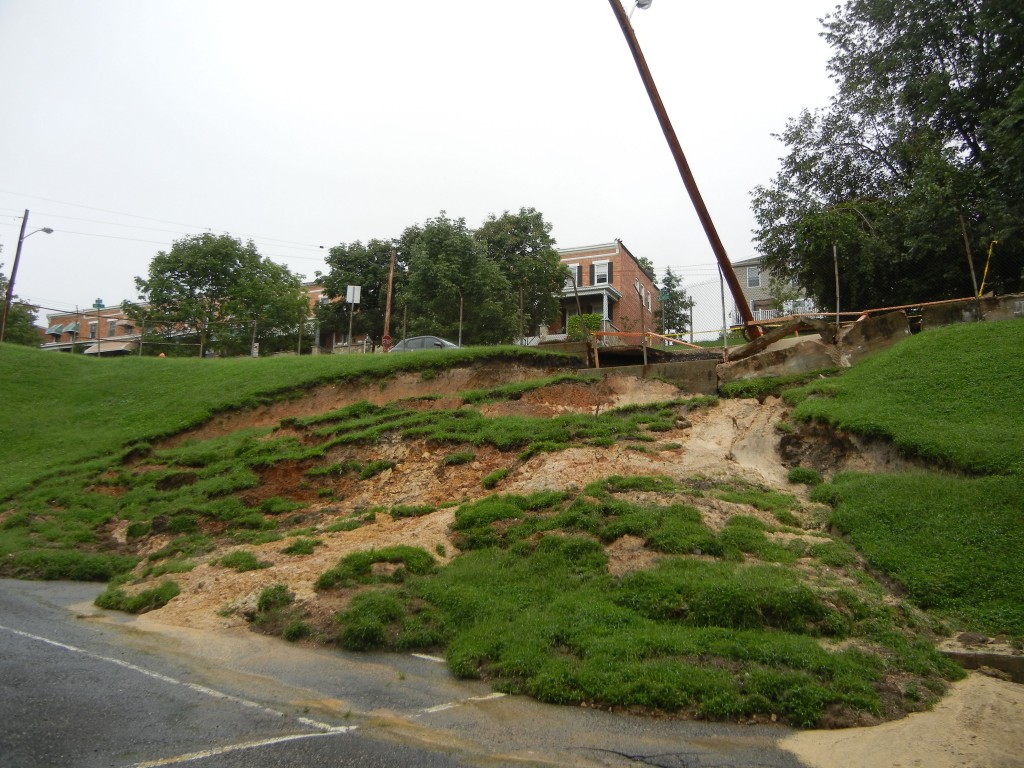 9/9: Tropical Storm Lee finally leaves. Baltimore had gotten another 8.11 inches of rain. The secondary slump is now a small cliff, the sidewalk has broken through the retaining wall, and the retaining wall is retaining nothing. The light pole looks like it’s exceeded its own angle of repose.
9/9: Tropical Storm Lee finally leaves. Baltimore had gotten another 8.11 inches of rain. The secondary slump is now a small cliff, the sidewalk has broken through the retaining wall, and the retaining wall is retaining nothing. The light pole looks like it’s exceeded its own angle of repose.
9/9 to 9/12: Period of normal weather, a few afternoon thunderstorms, not worth noting. The city of Baltimore, thinking hard, decides that if the electric line comes down off that light pole, it might just electrify the whole wire fence. The city removes the electric line.
9/13: Two contractors come out in two trucks, one with a cherrypicker and the other with a kind of corkscrewed power lifter. The guys loop a chain over the top of the light pole, sledgehammer the sidewalk, casually power the pole out of the ground, lay it down tidily along the sidewalk, police up the site, and drive away — 40 minutes max.
9/20: Stalled cold front. Not much rain so far. The city of Baltimore drives up in a little white pickup, pulls over next to the slump, gets out, adjusts its baseball cap, pulls up its t-shirt, and scratches its considerable tummy. It looks thoughtfully at the sidewalk, now a good four feet down, and at the retaining wall sliding down the hill; and then gets back into the truck and leaves.
9/23: Cold front still stalled. Flash flood warning. The rain is dropping straight out of the sky, 3.19 inches of it. The secondary slump is indistinguishable from the primary one, and the primary one crawls farther out on the parking lot. Now and then a clump of dirt rolls down the hill. The hill must feel a soft, uncertain, pulling creep; it must feel like its covers are sliding off its bed.
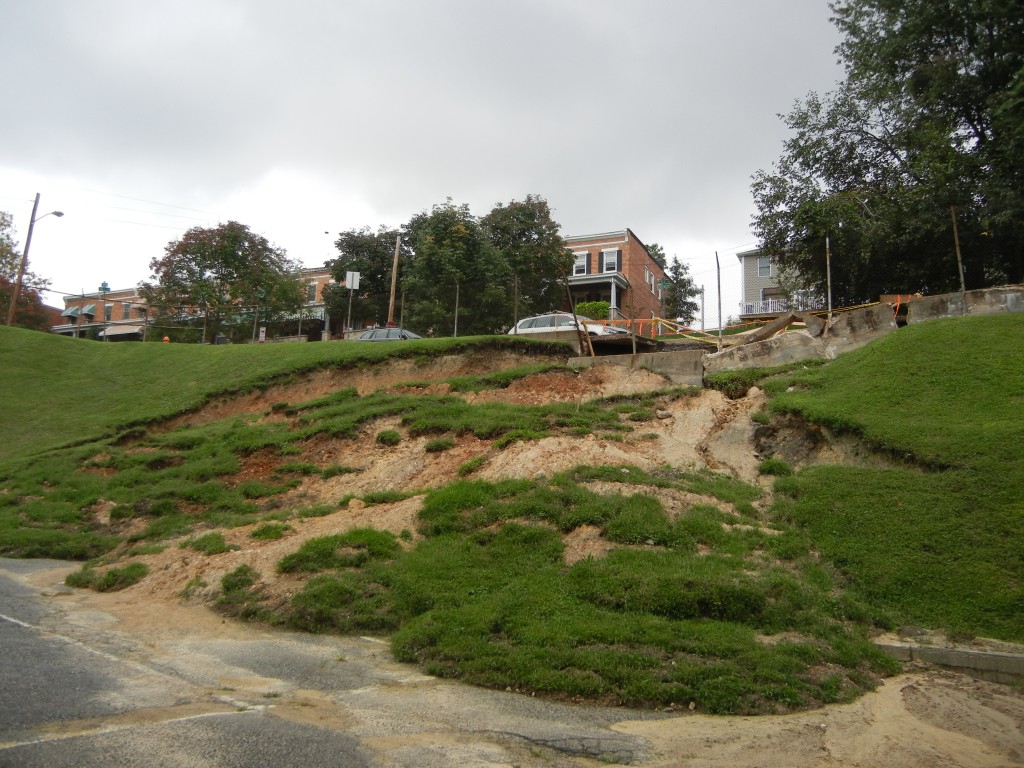 9/27: Heard on the radio this morning that this has been Baltimore’s rainiest September in recorded history. Building management and the city of Baltimore are having an argument over who pays what. Until they settle it, they won’t even begin to fix the sidewalk and fill in the hill. Meanwhile, NOAA says rain should continue for the next three days; gravity still has only one thing in mind; and the hill has no reason to stop slumping. Outside my window is what happens when politics and economics go up against groundwater and gravity.
9/27: Heard on the radio this morning that this has been Baltimore’s rainiest September in recorded history. Building management and the city of Baltimore are having an argument over who pays what. Until they settle it, they won’t even begin to fix the sidewalk and fill in the hill. Meanwhile, NOAA says rain should continue for the next three days; gravity still has only one thing in mind; and the hill has no reason to stop slumping. Outside my window is what happens when politics and economics go up against groundwater and gravity.
9/30: The rule, now and forevermore: don’t mess with gravity and groundwater. Respect them because they always — one way or another, sooner or later — always, always win.
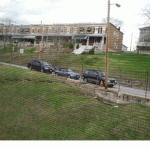
And so that you can remember this, my friend Julia has made for you a little Slideshow of Doom. Click on it and it animates itself.
______
Photo credits: The 4/20 picture I took with my cell phone. The rest were taken by the generous, adventuresome, and omnicompetent Julia Evins, running up and down 19th century circular stairs, climbing on desks, hanging out windows, saying, “Oh my, this is interesting.” Later she says, “When are they going to fix this? And how? how can they ever fix it?” I can’t answer her.
I love these pictures. To me, it looks like the hill has vomited, or spilled its guts.
10/1: I can’t wait to hear what happens next. Do you think the slow motion disasters–geophysical and econo-political–have stabilized, or is there more potential energy to be released?
In the meantime, I shed a tear for the poor bastard who, after years of loyal service, was finally rewarded with the choice parking spot at the bottom of the slope.
Great timeline! I also work in the building and we have 2 smaller slides right outside our windows, farther along the hill. It’s like a slow-motion car crash.
More City people out there this morning in a blue truck, kicking the other side of the hill.
Erin: Ooh ick. But I’ll tell Julia you like her pictures.
Tom: I can’t think it’s over. But I needed to get the post up today. Also, see Val, below.
Val: I know about those little slides! I’ve been watching them too and they’re following exactly the same trajectory as the big one. The city guys weren’t kicking the side of the hill with the stone wall, right? I don’t see which side you mean and golly Ned, I really want to know.
In Marin County where I grew up, we have lots of hill slides due to the very deep soil in most places and the “napas” – active water tables, as they were called in the area. In one case after a major storm, the hillslide started to slide with a home on it. The home slid with the hill, but became free of the ground and also slid along the ground. It ended up hitting another house. The insurance company refused to pay for damages to the second house because it had not been “damaged by the slide,” but by a house. It went to court and I never knew what happened.
See, Nick? See? I knew it never paid to go against ground water and gravity. That’s a sort of horrifying story.
Thank you so much for noticing, documenting, and sharing this observance of the interaction between nature and… well.. human nature 😉
Wow. I have to hand it to you. This is an awesome documentary (kind of like the one you see on TV). Only, this is reality. This could go down in history heaven forbid something formidable happens. I find your intuitiveness very commendable and the situation dangerous. The building management and the local officials should really get over their differences and do something about this for everyone’s safety. Have you tried getting in touch with that scientist again? Maybe involving the media would speed things up? hehe. Or how about writing to the president? hehe. Seriously, I fear for your safety. It looks like the damage is escalating for the worse. Who knows what a small scale earthquake can do to it.
Darren, the danger to the building is probably small. I do worry about the street collapsing though, so every day I check to see whether the ground is eroding back under the street. So far it’s not. But thank you for your concern.